I'll say this once and then I'll shut up. Smoking is as much a marketing problem as it is a public health problem. Therefore, the people coordinating anti-smoking campaigns should be marketing professionals, not Public Health officials.
According to a recent New York Times' editorial, a research published in the American Journal of Public Health shows that "exposure to tobacco company youth-targeted smoking prevention advertising generally had no beneficial outcomes for youths". Well, this shouldn't be a total surprise, since this is more of a PR move by the industry, trying to prevent further backlash from the society.
But I see other anti-smoking campaigns and I can't help getting the feeling that this is an incredibly one-sided battle. While one side has mastered how to pull all the culturally relevant strings directed at the youth (to start with, think Bogart and Bacall, James Dean, Brando) and keeps pushing the coolness envelope with persuasive, cutting edge marketing messages (branded content, sports sponsorships, and many other activities), the other side insists in promoting the health problems caused by smoking (often using gruesome images attached to the packaging).
I don't have any data on my hand, so I may be wrong, but I think this approach is highly ineffective. It only reaches smokers who already want to quit, and it doesn't really prevent youngsters from falling to the temptation of trying smoking just a couple of times. By the time they're hooked, it's too late.
If Public Health officials are serious about fighting the tobacco industry then they should hire marketing people with deep knowledge of human motivation, meaning management, consumption rituals, and myth creation, to manage their anti-smoking campaings. And if they are really serious, they should rally other countries' governments to join them in a global, cooperative, communication effort (after all, aren't the "enemies" global as well?).
But it'll never happen, so I'll just shut up.
Reference:
Editorial. When Don't Smoke Means Do. The New York Times. November 27, 2006. (here)
Thursday, November 30, 2006
smoking is a marketing problem
Posted by
Nelson
at
2:05 PM
1 comments
![]()
Labels: "meaning management", provocation
where do ideas come from?
As the end of the year draws near, it's now time to join your co-workers for company parties. Some will risk going to a karaoke (we've all been there, haven't we?).
And it occurred to me that the karaoke is nothing more than a modern version of the old Max Fleischer cartoons with the "famous bouncing ball", which invited us to sing along. I used to watch these cartoons as a kid, and remember sitting in front of the TV absolutely enthralled by that bouncing ball. Here's Popeye singing his theme song (here).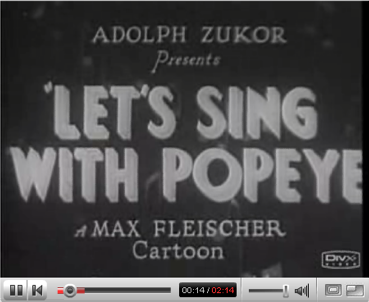 From Popeye and the bouncing ball, we went to this. Enjoy it (and I bet you'll sing along).
From Popeye and the bouncing ball, we went to this. Enjoy it (and I bet you'll sing along).
Posted by
Nelson
at
12:07 PM
0
comments
![]()
Labels: creativity, culture
Wednesday, November 29, 2006
brands and pop culture
Two examples of brands that are trying to engage pop culture:
The first one actually is a co-branded effort between Nerf's Showtime Hoops and AND1. Showtime Hoops is a basketball kit that promises to bring the excitement of streetball right into your living room. It has an attached sound system that says when you hit a good shot and when you didn't, all emceed by AND1's Duke Tango. AND1 has been a phenomenon. Riding the wave of NBA's success but trailing an entire different path, the brand has built its reputation as the street, hip-hop version of the (then) clean-cut NBA. They stand for a lifestyle now, selling shoes, DVDs, video-games, magazines, etc. See the TV commercial here. The other example is Burger King's launching of three X-Box games featuring "the creepy king from the US commercials" (via uncrate.com). You can buy one at US$ 3.99 with the purchase of a Value Meal.
The other example is Burger King's launching of three X-Box games featuring "the creepy king from the US commercials" (via uncrate.com). You can buy one at US$ 3.99 with the purchase of a Value Meal.
Posted by
Nelson
at
5:44 PM
0
comments
![]()
Labels: "pop culture", brands
Tuesday, November 28, 2006
i hate (brand name)
 When you become a celebrity, some people will like you, but some will not.
When you become a celebrity, some people will like you, but some will not.
There's an interesting article in the New York Times Magazine about this celebrity fate, showing the case of the "Rachel Ray Sucks Community".
Rachel Ray is not well known in Asia, but she's big in the US. She's a television food celebrity. She has her own TV show, her own magazine, has written many cooking books, and recently started her own talk-show. But what sets her apart is her ebullient character. According to Grant McCracken, "stylistically, Rachael Ray is the anti-Martha...Where Martha Stewart was cool, authoritative, self possessed, as if from the manor born, Rachael Ray is warm, improvisational, unassuming, and just folks. If Martha Stewart was ceremonial perfection to home making, Rachael Ray captures the "close enough is good enough" spirit that animates most American households."
Grant obviously thinks highly about Ray's approach, arguing that she's rescuing the rituals and meanings involved in food preparation and consumption, something that has been largely forgotten recently by TV food shows, with much of their focus being only on the food preparation (and not on what happens after the food is cooked). I've never watched her show but I tend to listen to what Grant says.
So, I was a little surprised that the number of Ray haters (how do you call them?) was so large. According to the NYT's article, the group has more than 1,000 members, whose common trait is to be "anti-Rachel". They criticize "...her cooking skills, her overreliance on chicken stock, her kitchen hygiene, her smile (often compared to the Joker’s), her voice, her physical mannerisms, her clothes, her penchant for saying “Yum-o” and so on. The general tone is suggested by the community’s name for the object of its united spite: “Raytard.” Ouch!
It came to mind that in this age of consumer activism, people are more than willing to share their dislike for a particular brand, forming these anti-fan groups. And brands (and if you become a celebrity, you become a brand, for good and for bad) inevitably will have to learn how to manage this sort of manifestation. Or, as Über-Planner Russell Davies says, brands will have to keep the conversation open.
Because even if you're very successful (or exactly because of it) there'll always be some people who will not like you. Take a look at this list compiled by Organic Frog. Apple, Nike, Starbucks, Ikea, Samsung, Tesco, PS3, Microsoft, all these brands (and many others) have very dissatisfied (not to say downright angry) consumers who'll go to great lengths to voice their opinions.
Reference:
Walker, Rob. Anti-Fan Club. The New York Times Magazine. November 26, 2006. (here)
Posted by
Nelson
at
6:19 PM
0
comments
![]()
Labels: "meaning management", activism, brands, celebrity
Friday, November 24, 2006
it's ok to be lonely
 There's a very interesting piece at Creative Review (CR) about the findings of Getty Images' Map Report. According to Getty, “advertisers will no longer shy away from depicting the individual without relationship ties.”
There's a very interesting piece at Creative Review (CR) about the findings of Getty Images' Map Report. According to Getty, “advertisers will no longer shy away from depicting the individual without relationship ties.”
They claim this based on the purchasing patterns in their website, plus: a study of 50,000 searches conducted in the last 12 months, 120 re-branding exercises conducted for its clients, tearsheets from the 260 magazines read per week by its Creative Research department, and a survey of 500 advertising creatives around the world.
CR writes a very intelligent review of the report, acknowledging some of the insights while rebuffing the unnecessary marketing buzzwords (when will we ever learn to speak like normal people?).
Here's an excerpt: "It’s OK to be alone. While in the past, advertising may have conspired to makes us feel utterly inadequate unless surrounded at all times by a coterie of guffawing supermodels, images of solitude are the growing trend in global visual culture....So say Getty Images whose Map Report claims to “capture the concepts that are shifting global culture and will become hot themes for the world’s media”. Having spent decades deriding singletons as losers with all the social skills of a rock, advertisers now want to make friends with those of us with just the one toothbrush in our bathroom. And it’s not just because, with no family to support, single people are wont to fill their empty lives with pointless new purchases. Being on your own is now, apparently, an aspiration...It’s all wrapped up in an 11,000 word report which, though blighted by some of the worst marketing bollocks ever committed to paper, nevertheless contains some intriguing insight. We’ve read it so you don’t have to – OK, we didn’t read it all, it’s not like we’re some sad loser with no friends…". Read the entire review here.
Posted by
Nelson
at
4:45 PM
0
comments
![]()
Labels: advertising, society
men don't buy their own underwear
I was doing some research on a topic and came across this. And it occurred to me that this is absolutely one of the points that make men so different in their buying behavior from women.
Take a look at this excerpt from Paco Underhill's book "Why We Buy":
"Men have always bought their own suits and shoes, but women, traditionally, shopped for everything in between. Especially they bought men's socks and underwear. Now, though, that's changing-men are more involved in their clothing, and women have enough to do without buying boxer shorts. In Kmart menswear departments, you'll still sometimes find a female-male ratio of 2 to 1 or even 3 to 1. But in expensive apparel stores, among more affluent men, males shopping for menswear now — finally — outnumber females."
Very well, this behavior seems to be slowly changing, but I believe that there are still many of us out there who let their wives and mothers buy their underwear for them, as seen in this Czech report that says, "...almost 60 percent of men surveyed admit to not having bought a single pair in the last twelve months. Another 60 percent were unable to name any brands of underwear. Most Czech men, it appears, prefer to let their mothers, sisters, wives, and girlfriends do the shopping".
And apparently this is a truly global phenomenon, as shown in this New Zealander history project, where one of the tasks is to "follow up the market research which suggests the majority of New Zealand males do not buy their own underwear...".
So, what does it say about us, men?
I once heard (coming from a woman) that "this only proves that men are just grown children". Go argue with that.
Posted by
Nelson
at
1:49 PM
2
comments
![]()
Labels: behavior, consumption, men, society
Thursday, November 23, 2006
wedding
Went to a Chinese lunch-wedding last Sunday, the first one we went to in Singapore. Few rituals are more revealing about a particular culture than weddings. It tells a lot about the history and the values of the people, and for a foreigner this is fascinating. So I approached the lunch with curiosity, but I have to confess that I was a bit apprehensive as well, as I had never been to a Chinese wedding before.
As we arrived, the groom warmly greeted us at the entrance, then led us to our table. After a nice, simple ceremony, we were treated to a nine-course Chinese lunch. And if I had any hint of apprehension before, it was totally unjustified, as I'll show you. Let me guide you through the banquet:
1. Lobster salad: small bits of lobster and fruits. Very nice. 2. Braised shark's fin soup with crab meat and golden mushroom (I know, not environmentally friendly, and I wouldn't order it myself at a restaurant, but I was told this is a must-have dish at Chinese weddings. It's very expensive, and it's delicious).
2. Braised shark's fin soup with crab meat and golden mushroom (I know, not environmentally friendly, and I wouldn't order it myself at a restaurant, but I was told this is a must-have dish at Chinese weddings. It's very expensive, and it's delicious). 3. Stir-fried scallops and twin mushrooms with asparagus. Very good as well, the scallops were tender and the asparagus were nicely done (crispy and with a subtle earthy flavor).
3. Stir-fried scallops and twin mushrooms with asparagus. Very good as well, the scallops were tender and the asparagus were nicely done (crispy and with a subtle earthy flavor). 4. Steamed "live" prawns. They are not actually alive when they reach the table (but they were when they were thrown into the steaming pot)
4. Steamed "live" prawns. They are not actually alive when they reach the table (but they were when they were thrown into the steaming pot)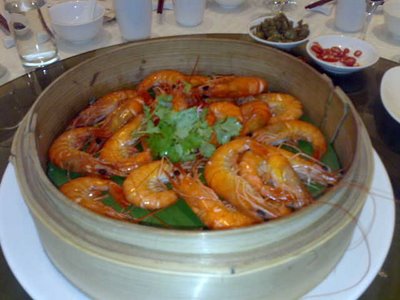 5. Braised baby abalone with fish maw in oyster sauce. My least favorite dish, a little too chewy for my taste.
5. Braised baby abalone with fish maw in oyster sauce. My least favorite dish, a little too chewy for my taste.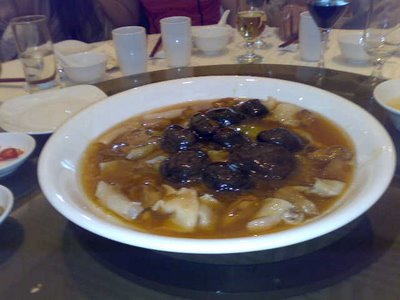 6. Steamed "live" garoupa in Hong Kong style. Same thing as the prawns. That's what you call a fresh fish. Tastes very good.
6. Steamed "live" garoupa in Hong Kong style. Same thing as the prawns. That's what you call a fresh fish. Tastes very good. 7. Braised duck with lotus seed and sea cucumber (are you still with me?). The duck was juicy and tender, but the sea cucumber is not really my thing (it's not bad, but it has the taste and consistency of "water jelly").
7. Braised duck with lotus seed and sea cucumber (are you still with me?). The duck was juicy and tender, but the sea cucumber is not really my thing (it's not bad, but it has the taste and consistency of "water jelly"). 8. Braised Ee-Fu noodle. Noodles with mushroom and bean sprouts. This is really good. I used to have this at Crystal Jade, a local Chinese restaurant chain.
8. Braised Ee-Fu noodle. Noodles with mushroom and bean sprouts. This is really good. I used to have this at Crystal Jade, a local Chinese restaurant chain. 9. Double-boiled snow fungus with papaya. The dessert. It's more like a hot, sweet soup, with some pieces of papaya.
9. Double-boiled snow fungus with papaya. The dessert. It's more like a hot, sweet soup, with some pieces of papaya. I didn't eat all these dishes by myself, in case you're wondering. The waiter would bring the dishes in a big bowl or plate and then would serve us in individual bowls like these below.
I didn't eat all these dishes by myself, in case you're wondering. The waiter would bring the dishes in a big bowl or plate and then would serve us in individual bowls like these below. The best was yet to come however (or so we thought). Ever since we'd entered the saloon, we had had our eyes on this beautiful layered cake.
The best was yet to come however (or so we thought). Ever since we'd entered the saloon, we had had our eyes on this beautiful layered cake.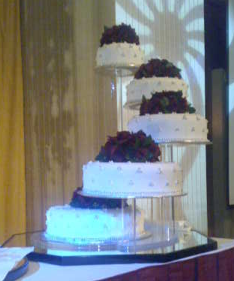 I was a little puzzled however, when I noticed people leaving the party after the dessert. To our surprise, our Singaporean friends who were with us at the table, told us that the cake was just a mock-up, it wasn't a real cake, it was just for the photo, something common at Chinese weddings here.
I was a little puzzled however, when I noticed people leaving the party after the dessert. To our surprise, our Singaporean friends who were with us at the table, told us that the cake was just a mock-up, it wasn't a real cake, it was just for the photo, something common at Chinese weddings here.
This is the wonderful thing about culture. When you think you have learned the codes, assimilated all the subtleties of the unwritten rules, something like this catches you totally by surprise. There's always something new to learn. "Just for the photo"..., very interesting.
We were a little bit disappointed, but at the same time I felt relieved there was nothing else to eat. Needless to say, we could barely walk after this gastronomic experience. The bride and groom were very kind in inviting us for their wedding. I left with my stomach full and with a sense of gratitude for their generosity in sharing their culture with us.
Posted by
Nelson
at
6:14 PM
0
comments
![]()
Wednesday, November 22, 2006
of olympics, video-games, and pitches
 Writing the last post about Wii vs. PS3, it reminded me of the impressive presentation that won London the bid for the Olympic Games of 2012. It must seem like something totally unrelated, but those who saw Sebastian Coe's presentation here in Singapore, in July last year, can understand. In his speech, which some considered the performance of his life, Coe mentioned the diminishing role of sports for today's youth, in a world so full of "conflicting messages and competing distractions" (video-games, for example), and how London could help in bringing sports back to the center stage. It was a clever strategy, touching on the emotional role of sports much more than on any other rational argument. And it was delivered brilliantly by Sebastian Coe, in a speech that watching today still gives me chills. You can watch it here (click on "London's presentation). It's 45min long, but if you want to learn how you win an Olympic bid (or any business pitch, for that matter), that's the way you do it.
Writing the last post about Wii vs. PS3, it reminded me of the impressive presentation that won London the bid for the Olympic Games of 2012. It must seem like something totally unrelated, but those who saw Sebastian Coe's presentation here in Singapore, in July last year, can understand. In his speech, which some considered the performance of his life, Coe mentioned the diminishing role of sports for today's youth, in a world so full of "conflicting messages and competing distractions" (video-games, for example), and how London could help in bringing sports back to the center stage. It was a clever strategy, touching on the emotional role of sports much more than on any other rational argument. And it was delivered brilliantly by Sebastian Coe, in a speech that watching today still gives me chills. You can watch it here (click on "London's presentation). It's 45min long, but if you want to learn how you win an Olympic bid (or any business pitch, for that matter), that's the way you do it.
Posted by
Nelson
at
11:51 PM
0
comments
![]()
Labels: presentation, sports
Monday, November 20, 2006
wii vs ps3
Christmas season has definitely arrived. My wife and I have been shopping for a new video game for our 7-year-old son. We're torn between the PS3 and Nintendo's Wii (as is the rest of the world, I guess). So let me show you our recent experience looking for some information in their websites.
If you visit Wii's website, you'll notice that Nintendo's focus is on clearly establishing that there is a new way to play video games now. Take for example this Wii commercial (here), where two Japanese "Men In Black" knock on people's door inviting them with the catch phrase, "Wii would like to play". Pretty cool. You can also view how people from different parts of the world interact with the games using the new virtual console (here). You really get the impression that it's a whole new "ball" game. I was completely blown away by these videos. The days of playing video games sitting comfortably on the couch are definitely over.
You can also view how people from different parts of the world interact with the games using the new virtual console (here). You really get the impression that it's a whole new "ball" game. I was completely blown away by these videos. The days of playing video games sitting comfortably on the couch are definitely over.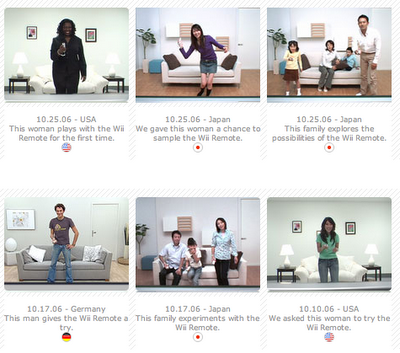 Now take PS3's approach in comparison. If you visit PS3's website, you'll have the impression you are entering the set of Kubrick's "2001. A Space Odyssey", with some mysterious black machine sitting in the corner of a cold white room. All you'll find is technical information, and lots of pictures of the console itself. If their goal was to show that this machine has supercomputing powers, I guess they succeeded. My question is if that's what it takes to sell the product.
Now take PS3's approach in comparison. If you visit PS3's website, you'll have the impression you are entering the set of Kubrick's "2001. A Space Odyssey", with some mysterious black machine sitting in the corner of a cold white room. All you'll find is technical information, and lots of pictures of the console itself. If their goal was to show that this machine has supercomputing powers, I guess they succeeded. My question is if that's what it takes to sell the product. And the commercial is really creepy (this is the US commercial. See here).
And the commercial is really creepy (this is the US commercial. See here).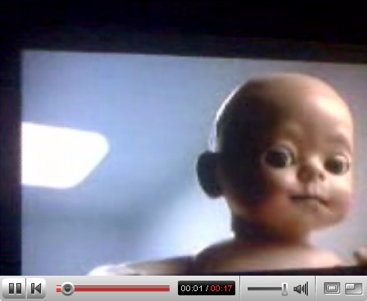 Now, which one would you prefer?
Now, which one would you prefer?
To be fair, one point we have to acknowledge is that both machines offer different performances (at least in terms of graphic quality) and analysts say that the PS3 is really a supercomputer for the price of a PC (see last post). Their suggested retail prices reflect that difference, the Wii selling for US$ 250.00, about half the price of a PS3.
And we? Well, I personally loved the Wii, but we won't be able to buy it now (nor the PS3) as both products are not going to be available for this Christmas anyway, after all this hype (which reminds me I have to buy something else for my son). So, we'll have more time to do some more research, but I have a slight suspicion that we're going to buy both of them in the end (such kid spoilers, I know).
Posted by
Nelson
at
9:12 PM
3
comments
![]()
Labels: games
sony losing money selling ps3
You really can't have any more secrets in this world. A company called iSuppli dismantled a PS3 to analyze its components. They reached the conclusion that Sony is losing up to US$ 300.00 for every PS3 unit they sell, depending on the configuration. “It’s common for video-game console makers to lose money on hardware, and make up for the loss via video game-title sales. Still, the size of Sony’s loss per unit is remarkable, even for the video-game console business,” iSuppli said. Still according to the company, the PS3 has “more processing power and capability than any consumer electronics device in history,” and consumers are to gain because they will get a supercomputer performance for the price of a PC (via Yahoo!News).
Posted by
Nelson
at
9:10 PM
2
comments
![]()
Labels: games
Saturday, November 18, 2006
world's largest mega ramp
Well, it was just a matter of time before somebody uploaded it to YouTube. Check it out, Bob Burnquist and his backyard mega ramp. (here)
Posted by
Nelson
at
9:30 PM
0
comments
![]()
Labels: sports
Friday, November 17, 2006
blue sky
It was lovely yesterday. Some white clouds, but that's fine.
And Christmas is already here. See Orchard Rd.

Posted by
Nelson
at
4:42 PM
0
comments
![]()
Labels: singapore
tiger brands
This might be something most people take for granted here in Asia but which strikes my foreign eyes. I see Tiger brands and Tiger-named companies everywhere. I've been collecting a few examples recently. See below:
Singapore's Tiger Beer. Japan's Onitsuka Tiger
Japan's Onitsuka Tiger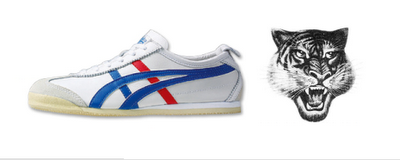
Singapore's Tiger Balm Asian Tigers K.C. Dat, a moving company
Asian Tigers K.C. Dat, a moving company
Tiger Air, a budget carrier
Japan's Tiger Appliances, a rice cooker maker China's Tiger Generator
China's Tiger Generator China's Guangzhou Tiger Head Battery
China's Guangzhou Tiger Head Battery China's Hang Zhou Tiger, maker of Tiger One Lamps
China's Hang Zhou Tiger, maker of Tiger One Lamps
Korea's LG Tiger One External Laptop Batteries Japan's Hanshin Tigers
Japan's Hanshin Tigers And so goes the list. I'm sure I'm missing some brands here.
And so goes the list. I'm sure I'm missing some brands here.
There's a simple reason for this profusion of Tiger brands throughout Asia. There are no lions here. Tigers therefore are the kings of animals. They've been part of Asian mythology for ages. There are countless tiger stories in most Asian countries, China, Korea, Vietnam, India, Japan.
The most important of all, of course, is the Chinese zodiac, the Tiger being one of the 12 animals that comprise the zodiac. A Tiger person is seen as a born leader. Famous Tigers include Queen Elizabeth II, Karl Marx, and Richard Branson. Apart from the zodiac there are several other tiger tales. In China's countryside, it's still common today for babies to wear these tiger shoes, with the belief that they'll help protect the babies from evil spirits. In Korea, there's a number of tiger inspired tales. And these tiger paintings are pretty common to spot hanging on the walls in Chinese and in Japanese residences.
In Korea, there's a number of tiger inspired tales. And these tiger paintings are pretty common to spot hanging on the walls in Chinese and in Japanese residences. Taking into consideration this background, it's clear to see that these Tiger brands are trying to tap into this rich cultural pot. Whether they are doing this intentionally or not is another question. But what strikes me most is that despite sharing the same name, they apparently are able to create different meanings for themselves. Tiger Beer, for example, is positioned as a cosmopolitan and cool beer brand, whereas nothing could be more traditional and local than Tiger Balm, a pain relieving ointment with an intense (some would say awful) menthol smell.
Taking into consideration this background, it's clear to see that these Tiger brands are trying to tap into this rich cultural pot. Whether they are doing this intentionally or not is another question. But what strikes me most is that despite sharing the same name, they apparently are able to create different meanings for themselves. Tiger Beer, for example, is positioned as a cosmopolitan and cool beer brand, whereas nothing could be more traditional and local than Tiger Balm, a pain relieving ointment with an intense (some would say awful) menthol smell.
This profusion of brands sharing the same name, as far as I remember, is not very common in the West.
But I found out that Tiger brands are not exclusively an Asia thing. While they don't exist in the same number as in Asia, there are quite a few examples. Let's take a look at some other Tiger brands around the world:
Detroit Tigers baseball team in the US. Apple's Tiger Operating System.
Apple's Tiger Operating System. There's also a big food company called Tiger Brands in South Africa, and a pipe company called Tigre (Tiger in Portuguese) in Brazil.
There's also a big food company called Tiger Brands in South Africa, and a pipe company called Tigre (Tiger in Portuguese) in Brazil.
And of course, there's Tony the Tiger. While not properly a brand, it's such a strong icon that it almost eclipses the Kellogg's brand. And finally there's Tiger (as in "Woods"), who, being half-Asian, could very well have entered the Asian tally as well.
And finally there's Tiger (as in "Woods"), who, being half-Asian, could very well have entered the Asian tally as well. Tiger Woods is well on his way to become the first sportsman to reach US$ 1 billion in earnings, which I believe easily put him among the top 3 most valuable brands in the above list. This Woods phenomenon will inevitably spur the creation of a new wave of Tiger brands, and probably will add another layer of meanings to the noun "tiger" as well. Speaking of that there's already speculation that "Tiger" is going to be one of the most popular baby names in the next decades. Can you imagine it? A new generation full of baby Tigers? Now, that would be something interesting to witness. Let's wait and see.
Tiger Woods is well on his way to become the first sportsman to reach US$ 1 billion in earnings, which I believe easily put him among the top 3 most valuable brands in the above list. This Woods phenomenon will inevitably spur the creation of a new wave of Tiger brands, and probably will add another layer of meanings to the noun "tiger" as well. Speaking of that there's already speculation that "Tiger" is going to be one of the most popular baby names in the next decades. Can you imagine it? A new generation full of baby Tigers? Now, that would be something interesting to witness. Let's wait and see.
Posted by
Nelson
at
2:26 PM
3
comments
![]()
Thursday, November 16, 2006
conspicuous consumption in north korea
(No comments. The news speaks for itself.)
In line with the UN sanctions imposed on North Korea in the wake of Pyongyang's nuclear test last month, Japan has announced the ban on luxury exports to that country.
According to the Japan Times, "the 24 items include beef, tuna meat, caviar and its substitutes, liquor, cars, motorcycles, motorboats, yachts, watches, cameras, audio and video devices, movie and music software, jewelry, carpets and tobacco. Kim (Jong Il) is believed to favor such items for his personal use as well as to give away as rewards for loyalty among Pyongyang's power elite, government officials said. We have (chosen) goods that are likely to be used by (government and party) executives, and those they are likely to give to their subordinates, Chief Cabinet Secretary Yasuhisa Shiozaki told a news conference."
Reference:
Yoshida, Reiji. Banned goods to North listed. The Japan Times. November 15, 2006. (here)
Posted by
Nelson
at
11:47 AM
0
comments
![]()
Labels: asia, north korea
Wednesday, November 15, 2006
design that makes a difference
I found this via Dany (thanks Dany).
In the aftermath of Hurricane Katrina, many people found themselves living in FEMA trailers, offered as a practical solution for temporary housing. There are currently approximately 99,000 of these trailers in Louisiana and Mississippi. Experience shows that these temporary shelters however tend to become permanent as people struggle to put their lives back on track. Many years after Hurricane Andrew hit Florida, there are still people living in trailers there. Besides, there's the decrease in property value and the increase in criminality in areas where these trailers stay for too long, a decline in self-worth perhaps driving urban decay. A trailer can be a practical, quick solution, but there's a sense of impermanence about it. You don't build a community back to normal life if most people are living in them. As one trailer resident says, "Have you been in a FEMA trailer? It's like living on a navy ship."
Experience shows that these temporary shelters however tend to become permanent as people struggle to put their lives back on track. Many years after Hurricane Andrew hit Florida, there are still people living in trailers there. Besides, there's the decrease in property value and the increase in criminality in areas where these trailers stay for too long, a decline in self-worth perhaps driving urban decay. A trailer can be a practical, quick solution, but there's a sense of impermanence about it. You don't build a community back to normal life if most people are living in them. As one trailer resident says, "Have you been in a FEMA trailer? It's like living on a navy ship."
It was thinking about an alternative to the trailer that designer Marianne Cusato came up with this cute cottage idea.


She says she "wanted to create a more dignified version of the FEMA trailer". Named Katrina Cottage, it's about the same size as the trailer and it costs about the same as well, about US$ 35,000 (there are other larger, more expensive models now). But the great thing about it is that it brings a whole different feel to a devastated area. The cottage has a creole-inspired design that evokes a nice homey feeling to it. It even has a front porch, opening the possibility for residents to meet neighbors and passersby. It's also designed to allow for future expansions.
Recently, Ms. Cusato was awarded the Smithsonian's Cooper-Hewitt, National Design Museum, People's Design Award.
References:
Fornoff, Susan. The Little House That Roared. San Francisco Chronicle. March 4, 2006. (here)
Perry, Rex. Katrina Cottages. Cottage Living. July/August 2006. (here)
Rybczynski, Witold. The Katrina Cottage. Slate. March 31, 2006. (here)
Posted by
Nelson
at
4:37 PM
2
comments
![]()
Tuesday, November 14, 2006
belgium not famous for wine
Another country of origin post (first Norway, then Hawaii, now Belgium). I noticed this ad on I-S Magazine the other day. This is a great example of using the negative form to call attention and to position the brand. Indeed, off the top of your head, why is Belgium famous for besides their beer? It must be a nice place to visit.
Posted by
Nelson
at
2:31 PM
2
comments
![]()
subscription problems
I have received a couple of complaints about people subscribing to this blog via email but being unable to receive the updates. I checked with Feedburner and they have this recommendation:
===================
Some people have problems clicking on the link provided in the confirmation email. You might want to ask the subscriber to, upon receiving the confirmation email, just after they sign up, to copy and paste the link into the browser. It should take them straight to the confirmation page. Then it should work.
===================
Hope this helps. Let me know if you're having problems.
Posted by
Nelson
at
11:43 AM
0
comments
![]()
Labels: subscription
Monday, November 13, 2006
strolling in pyjamas
There was an interesting piece on yesterday's Sunday Times (subscribers only, but you can read the same story here).
It was about the controversy revolving around an old habit that some Shanghainese people have of wearing pyjamas in public. Shanghai is arguably China's most modern city and yet it's still common to see residents wearing pyjamas in public during daytime. According to the report "they cruise by on bicycles. They sip tea in quiet teahouses in the park". A recent survey conducted by the Shanghai Academy of Social Science "found out that about 16% of respondents said they or family members often wear pyjamas in public. It is also considered one of the most irritating features of Shanghai city life."
I suppose it's really strange to bump into somebody wearing pyjamas during the day in public, but if you think about it, it makes a whole lot of sense. Although Shanghai is riding an incredible modernization boom, there are still many residents who live in old homes and share public bathrooms, so it's just practical to go out in pyjamas when nature calls. Well, from the bathroom to the coffee shop down the corner is just a short stroll, and so out they go, clad in their pyjamas. For some, it can be seen as a sign of bad taste, a fashion faux-pax, or simply laziness, and for people who live there it must not be nice to witness the daily display of the not-so-latest pyjama fashion.
But, I think this peculiarity is one of the things that makes Shanghai an interesting place to visit, this is just the type of thing that adds colour to the city. The contrast between the super-modern architecture and the pyjama-wearing crowd. Without them, Shanghai will be just another modern city, full of mega-malls and properly attired people. And someday, we'll fondly remember the days we could bump into a guy dressed like this (thanks to preciouspirate).
Reference:
Morgan, Benjamin. Pyjama Party. The Sunday Times. November 12, 2006.
Posted by
Nelson
at
1:35 PM
1 comments
![]()
Sunday, November 12, 2006
where do ideas come from?
An excerpt from Chris Rock's interview to The New York Times Magazine:
----------------------------
How would you describe your creative process?
I try to come up with a crazy hypothesis and prove it right comedically. You say something that makes no sense — women are physically stronger than men — and prove it right. That’s kind of what you do.
Are you constantly jotting down ideas for potential jokes?
I’ve got a list on my
So what have you got there, for instance?
Women who let their husband look better than them. If nothing else in the marriage, don’t let your husband look better than you. It’s a disaster for everybody. One thing about families, if it’s bad for one of you, it’s bad for the family.
----------------------------
Reference:
Solomon, Deborah. The Funny Formula. The New York Times Magazine. November 12, 2006 (here, with restrictions)
Posted by
Nelson
at
9:05 PM
2
comments
![]()
Labels: creativity, humour
Saturday, November 11, 2006
playstation 3
This via Jean Snow.
Today, Saturday, is the launch of Playstation 3 in Japan. Jean went last night to Ikebukuro, at midnight, to check out the queue. As expected, there were already some people prepared to wait through the night to get a PS3.
Posted by
Nelson
at
4:24 PM
0
comments
![]()
Labels: games